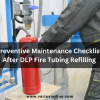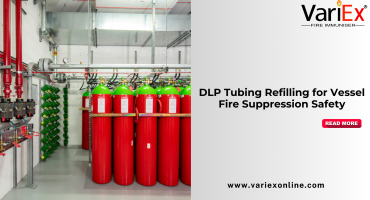![]()
Fire Immuniser
+91-7829629111
Email: info@variex.in
Varistor Technologies Pvt. Ltd.
Block-1, First Floor, Ardente Office One, Hoodi Circle, ITPL Main Road, Bengaluru, Karnataka 560048, IN
Fire Extinguishers Gas Refilling: A Must-Know for Your Safety!
In the realm of fire safety, there's a critical aspect that often escapes our attention but holds paramount importance – "Fire Extinguishers Gas Refilling: A Must-Know for Your Safety!" In a world where emergencies can strike at any moment, the functionality of a fire extinguisher becomes a pivotal factor in averting potential disasters. This blog takes a deep dive into the significance of fire extinguishers gas refilling, emphasizing why it's not just a routine task but a fundamental element in safeguarding lives and property. Whether you're a homeowner, business proprietor, or someone who values safety, understanding the intricacies of fire extinguisher maintenance is indispensable. Let's unravel the nuances and empower ourselves with the knowledge necessary to protect what matters most.
Picture fire extinguishers as your frontline defenders against unexpected flames, each designed for specific types of fires. From the ones using water to those with dry powder or CO2, they're like superheroes with unique powers. Now, here's the catch: these heroes need a bit of attention to stay ready. Regular check-ups are their version of a health check to make sure they're fit for action. Imagine if Batman didn't maintain his gadgets – not very effective, right? But there's one crucial part in their upkeep – gas refilling. It's like giving them a power boost. Whether it's CO2 or powder, refilling ensures they have enough juice to tackle a fire head-on.
Types of fire extinguishers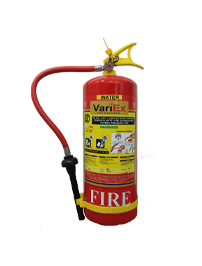
Water-Based Fire Extinguishers: Water extinguishers, the simplest in design, find their strength in tackling Class A fires, involving ordinary combustibles like wood, paper, and textiles. Their mechanism lies in the ability to cool the fire, extracting heat and thwarting the re-ignition process. However, caution must prevail, as they prove ineffective and hazardous when faced with flammable liquid or electrical fires.
Foam Fire Extinguishers: Foam extinguishers emerge as versatile contenders, proficient in handling both Class A and B fires. Their efficacy shines in situations involving flammable liquids such as petrol, diesel, and oil. The mechanism involves the formation of a foam blanket over the fuel surface, preventing the release of flammable vapors. Yet, one must exercise caution, steering clear of their use on electrical fires and recognizing their potential to cause damage to sensitive equipment.
Dry Powder Fire Extinguishers: Known for their adaptability, dry powder extinguishers prove effective across Class A, B, and C fires, making them a preferred choice for situations involving flammable gases. The mechanism revolves around smothering the fire, forming a barrier that cuts off the oxygen supply. Despite their versatility, caution is warranted, as they exhibit limited effectiveness on Class A fires, and the residue they leave can pose issues for sensitive equipment.
CO2 Fire Extinguishers: Tailored for specific hazards, CO2 extinguishers find their niche in combating electrical fires (Class C) and those involving flammable liquids (Class B). The mechanism involves the displacement of oxygen, creating a blanket that starves the fire of its essential element. However, users must exercise caution, recognizing their unsuitability for Class A fires and the potential risk of suffocation in confined spaces due to the discharged gas.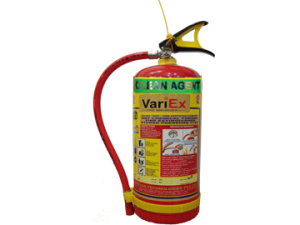
Wet Chemical Fire Extinguishers: Uniquely crafted for the challenges posed by Class K fires, particularly those involving cooking oils and fats, wet chemical extinguishers employ a mechanism that creates a soapy solution. This solution not only cools the burning oils but also emulsifies them, preventing re-ignition. It's crucial to note their limitations, as they may not prove as effective in dealing with fires from other classes.
Clean Agent Fire Extinguishers: In environments where sensitivity to electronic equipment is paramount, clean agent extinguishers shine. Effective against Class A, B, and C fires, these extinguishers release a gas that removes heat and interrupts the combustion process. However, the advantages come at a cost, both in terms of expense and environmental impact, requiring careful consideration in their application.
When is Fire Extinguisher Gas Refilling Necessary?
Fire extinguisher gas refilling becomes a necessity under various circumstances. Firstly, it's crucial after the extinguisher has been used, even partially. The discharge of its contents, whether it's CO2, dry chemical powder, or another gas-based medium, depletes its capacity to respond to subsequent emergencies. Refilling is essential to restore the extinguisher to its optimal operational state, ready for any unforeseen events.
Additionally, routine inspections and maintenance may reveal gradual pressure loss or other factors indicating a potential decline in the extinguisher's effectiveness. In such instances, proactive gas refilling is a preventive measure, ensuring the extinguisher is always prepared to tackle a fire.
Signs of a Depleted Fire Extinguisher
Understanding when a fire extinguisher is running on empty is crucial for maintaining a safe environment. Common signs of a depleted extinguisher include low pressure indicated on the gauge, visible damage or wear, and expiration of the extinguisher's service life. If you notice any of these signs, prompt action, such as fire extinguisher gas refilling, is necessary to keep the device in optimal working condition.
Importance of Timely Fire Extinguisher Gas Refilling
The importance of timely fire extinguisher gas refilling cannot be overstated. A fully charged and properly filled extinguisher is the first line of defense in the event of a fire emergency. Delaying or neglecting refilling can result in a non-functional device when needed most, leaving individuals and properties vulnerable to the devastating consequences of fires.
Regular gas refilling not only ensures that the extinguisher is ready for action but also extends its lifespan. It is a proactive approach to maintaining the reliability and efficacy of these critical safety tools. Moreover, adhering to a schedule of routine maintenance and timely refilling aligns with regulatory requirements and industry standards, enhancing overall safety compliance.
Common Fire Extinguisher Gases
Carbon Dioxide (CO2): Carbon dioxide extinguishers are tailored for combating Class B and C fires, involving flammable liquids and electrical equipment. The mechanism involves displacing oxygen, creating a blanket that deprives the fire of its vital element. However, it's important to note that CO2 extinguishers may require fire extinguisher gas refilling after use, as they may not offer post-fire security.
Dry Chemical Powder: Versatility is the hallmark of dry chemical powder extinguishers, making them suitable for Class A, B, and C fires in various environments. They create a barrier that interrupts the combustion process by cutting off the fire's oxygen supply. Routine inspections may reveal gradual pressure loss, prompting the need for fire extinguisher gas refilling.
Water-Based: Water-based extinguishers are primarily designed for Class A fires, involving ordinary combustibles like wood, paper, and textiles. Their mechanism involves cooling the fire by removing heat, preventing re-ignition. However, caution is advised, as they are unsuitable for flammable liquid or electrical fires, and periodic checks may necessitate fire extinguisher gas refilling.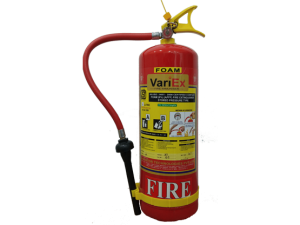
Foam: Effective against Class A and B fires, foam extinguishers are designed for situations involving flammable liquids. They form a foam blanket over the fuel surface, preventing the release of flammable vapors. Caution is advised, as foam extinguishers may require fire extinguisher gas refilling if used, and they can potentially damage sensitive equipment.
Wet Chemical: Specifically crafted for Class K fires, particularly those involving cooking oils and fats, wet chemical extinguishers create a soapy solution that cools and emulsifies the burning oils, preventing re-ignition. Periodic checks are essential, and fire extinguisher gas refilling may be necessary after deployment.
Steps in Gas Refilling Process
Check-up Time: Before anything else, our fire extinguisher gets a thorough check-up. We look at it closely to make sure there are no bumps, bruises, or other visible issues. It's like a doctor's visit for our safety sidekick.
Breathing Out: If our fire extinguisher has been used before, we need to let out any leftover firefighting stuff to ease the pressure. It's like letting out a breath so we can get ready for a deep inhale – in this case, a refill.
Taking Things Apart: Now, we take our extinguisher apart to see what's going on inside. We look at all the bits and pieces – the valves, hoses, and other parts – to make sure everything is in good shape. Think of it as opening up the hood of a car to make sure the engine is running smoothly.
Gas Refill: Here's where the magic happens. We fill our extinguisher back up with the right firefighting juice. Whether it's the cool CO2, the powdery dry chemical stuff, or another special mix, we make sure it's just the right amount. This step is like giving our extinguisher a refreshing drink to get it back to full power.
Pressure Check: After the refill, we want to make sure our extinguisher can still bring the heat (or rather, stop it). So, we give it a pressure check. It's like making sure a balloon is good to go before a big celebration – we don't want any leaks or weak spots.
Putting It All Back Together: Now that our extinguisher is refilled and pressure-checked, it's time to put all the parts back where they belong. It's like assembling a puzzle – every piece needs to fit snugly to make sure our safety buddy is in top form.
The Finishing Touch: To wrap it all up, we add a little tag with some info. This tag is like a certificate that tells us when our extinguisher had its last check-up and what kind of gas it's filled with. It's a way of keeping track of our safety superhero's history.
Safety Guidelines when refilling a fire extinguishers gas
Dress the Part: When you're gearing up for fire extinguisher gas refilling, think of it like getting ready for a DIY project. Dress in appropriate protective gear – safety glasses, gloves, and maybe even a smock – to shield yourself from any unexpected surprises.
Choose the Right Space: Imagine your work area as a calm and controlled superhero headquarters. Pick a well-ventilated space with enough room to move around. Keep away from open flames or anything that might spark – we want our safety superhero to stay focused.
Know Your Gas: Just like understanding the ingredients in your favorite recipe, know what gas your fire extinguisher needs. Different extinguishers require different gases, and using the right one ensures your safety superhero is armed and ready for the right kind of fire.
Handle with Care: Think of the fire extinguisher as a fragile package you're handling delicately. Avoid rough handling, drops, or any actions that might damage it. A little care goes a long way in maintaining the integrity of your safety sidekick.
Check the Labels: Labels are like the instructions for a board game – they guide you through the process. Pay attention to the labels on the fire extinguisher and the gas cylinder, ensuring they match. This simple step helps prevent mix-ups and ensures the right gas is going into the right extinguisher.
Slow and Steady Wins: Just like filling up a water balloon slowly to avoid spills, refill the gas into the extinguisher with a steady hand. Avoid rush or forceful actions – it's about precision, not speed.
Double-Check the Pressure: Imagine checking the air in your bicycle tires – you want to make sure it's just right. Similarly, double-check the pressure in the fire extinguisher after refilling. Ensuring the right pressure ensures your safety superhero can perform at its best.
Cleanup Time: After the refilling is done, clean up the workspace. It's like putting away your tools after a DIY project. Proper cleanup ensures a safe environment for future refilling missions.
Document the Deed: Think of it like updating your superhero's diary. Keep a record of when the gas was refilled, what type was used, and who performed the task. It's a small step that goes a long way in keeping track of your safety superhero's history.
As we wrap up our discussion on "Fire Extinguishers Gas Refilling: A Must-Know for Your Safety!", let's reflect on why understanding this process is crucial for our well-being.
Keeping Our Safety Heroes Ready: Think of fire extinguishers as our trusty superheroes, always ready to save the day. Gas refilling is like giving them a power boost, ensuring they're armed and prepared for any unexpected fires that might come our way.
Our Role in Safety: Understanding how fire extinguishers get their strength back is like being a superhero sidekick. It's about knowing how to support and contribute to our own safety and the safety of those around us.
A Never-Ending Safety Story: Gas refilling isn't a one-time thing; it's part of an ongoing safety journey. It's like regularly checking our car to make sure it runs smoothly – we want our safety tools to be in top shape, always there when we need them.
Empowered for the Future: Knowing about fire extinguishers gas refilling empowers us. It's like having a secret weapon against the uncertainty of emergencies. We face the future with confidence, knowing we have the knowledge to handle unexpected situations.
Promising Protection: Every time we talk about 'fire extinguishers gas refilling,' it's a promise. It's a commitment to protecting what matters – our lives and our belongings. It's a pledge to be proactive about safety, not just reactive when emergencies happen.
Building a Safer World: Understanding gas refilling is more than a personal benefit; it's a contribution to building a safer world. It's about creating a culture of safety in our homes, workplaces, and communities – a culture where everyone plays a part in looking out for one another.
So, as we wrap up our exploration, let's carry this knowledge forward, sharing it with friends, family, and neighbors. Let's create a world where safety isn't just a concept but a shared responsibility, and where 'fire extinguishers gas refilling' is a simple yet powerful mantra guiding us towards a safer and more secure future.
Frequently Asked Questions
1. Why is fire extinguisher gas refilling necessary?
Gas refilling is crucial for fire extinguishers to ensure they remain fully charged and ready for action. Over time or after use, extinguishers may lose pressure, making refilling essential for their effectiveness.
2. How often should fire extinguishers undergo gas refilling?
The frequency of gas refilling depends on factors such as the type of extinguisher, its usage, and manufacturer recommendations. Typically, it is part of regular maintenance checks or after any use to ensure continued readiness.
3. Can I refill a fire extinguisher without professional help?
Refilling should be performed by trained professionals to guarantee the correct type and amount of gas is used. DIY attempts may result in incorrect refilling, compromising the extinguisher's effectiveness and safety.
4. What are the signs indicating the need for fire extinguisher gas refilling?
Signs include a low pressure gauge reading, visible damage, or the expiration of the extinguisher's service life. Regular inspections and routine maintenance can help identify these signs, prompting the need for gas refilling.
5. Is gas refilling necessary for all types of fire extinguishers?
Yes, gas refilling is necessary for all types of fire extinguishers. Each type requires a specific firefighting agent, and refilling ensures that the extinguisher is equipped with the correct gas to combat the corresponding fire class.
Final Say
We at VariEx.in or Variexonline.com have mastered the art of designing, installing, inspecting, and fixing automatic sprinkler systems with the help of our in-house team, which is capable of delivering the fire sprinkler services you need, whether large or small and at affordable cost.
To schedule a fire sprinkler installation, or you think our services could benefit your commercial property, contact us online or give us a call at, 7829629111
"WHAT YOU CAN READ NEXT"
 Read more +24 November 2023 in Fire Extinguisher
Read more +24 November 2023 in Fire ExtinguisherWhat types of fire extinguishers are available for different fire classes?
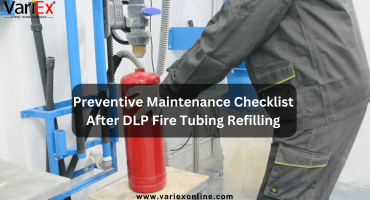 Read more +11 July 2025 in Fire Suppression
Read more +11 July 2025 in Fire Suppression



